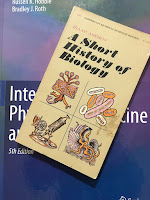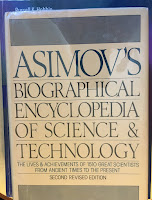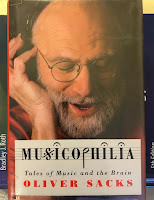 |
| The tobacco mosaic virus. |
 |
| A Short History of Biology, by Isaac Asimov. |
But twentieth-century serology [the study of plasma serum] reserved its most spectacular successes for the battle with microorganisms of a type unknown to [Louis] Pasteur and [Robert] Koch [founders of bacteriology] in their day. Pasteur had failed to find the infective agent of rabies, a clearly infectious disease undoubtedly caused, according to his germ theory, by a microorganism. Pasteur suggested that the microorganism existed but that it was too small to be detected by the techniques of the time. In this, he turned out to be correct.The tobacco mosaic virus has other claims to fame. In 1935 it became the first virus to be crystalized, by American biochemist Wendell Stanley, a feat for which he received the 1946 Nobel Prize in Chemistry. Two years later, English plant pathologist Sir Frederick Bawden showed that the Tobacco mosaic virus contained ribonucleic acid (RNA), suggesting that nucleic acids are crucial for life. Rosalind Franklin, famous for her roll in Watson and Crick’s discovery of the structure of DNA, later studied the structure of the tobacco mosaic virus. In their paper “Tobacco Mosaic Virus: Pioneering Research for a Century” (Plant Cell, Volume 11, Pages 301–308, 1999), Creager et al. write
The fact that an infectious agent might be much smaller than ordinary bacteria was shown to be true in connection with a disease affecting the tobacco plant (“tobacco mosaic disease”). It was known that juice from diseased plants would infect healthy ones and, in 1892, the Russian botanist, Dmitri Iosifovich Ivanovski (1864–1920), showed that the juice remained infective even after it had passed through filters fine enough to keep any known bacterium from passing through. In 1895, this was discovered independently, by the Dutch botanist, Martinus Willem Beijerinck (1851–1931). Beijerinck named the infective agent a “filtrable virus” where virus simply means “poison.” This marked the beginning of the science of virology.
Tobacco mosaic virus (TMV), as we now know the agent that Beijerinck and others were studying, was the first virus to be identified. Perhaps because of this, research on TMV and other plant viruses has continued to be of profound significance in addressing fundamental questions about the nature of viruses in general. Indeed, TMV as a model system has been at the forefront of virology research to the present time. For example, TMV was the first virus to be chemically purified (Stanley, 1935; Bawden et al., 1936), to be detected in an analytical ultracentrifuge and in an electrophoresis apparatus (Eriksson-Quensel and Svedberg, 1936), and to be visualized in an electron microscope (Kausche et al., 1939). TMV RNA was used in the first decisive experiments showing that nucleic acids carry hereditary information and that nucleic acid alone is sufficient for viral infectivity (Fraenkel-Conrat, 1956; Gierer and Schramm, 1956). The TMV coat protein (CP) was the first virus protein to be sequenced (Anderer et al., 1960; Tsugita et al., 1960), and TMV’s particle structure was among the first to be elucidated in atomic detail (Bloomer et al., 1978; Namba et al., 1989).What is the “mosaic” part of the virus name mean? A mosaic virus infects plants and causes the leaves to appear speckled. To learn more about this virus, read The Life of a Virus: Tobacco Mosaic Virus as an Experimental Model, 1930–1965 by Angela Creager (I have not read this, but it looks interesting, as does her more recent book Life Atomic: A History of Radioisotopes in Science and Medicine).
TMV’s preeminence has extended into the recombinant era, when the first transgenic plants were constructed using TMV to demonstrate the concept of CP-mediated cross-protection (Abel et al., 1986). TMV was also the first virus shown to encode a cell-to-cell movement protein (MP; Deom et al., 1987). MP binds to RNA (Citovsky et al., 1990), associates with cytoskeletal elements (Heinlein et al., 1995; McLean et al., 1995), and increases the permeability of plasmodesmata to mediate cell-to-cell movement of the virus (Wolf et al., 1989; Waigmann et al., 1994).
Russ must have known exactly what he was doing when he compiled Table 4.2 (and created Fig. 4.12), as he selected perhaps the most important virus historically, and one that has become a model system for microbiology.








